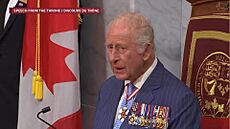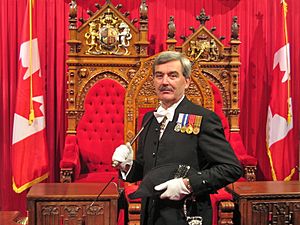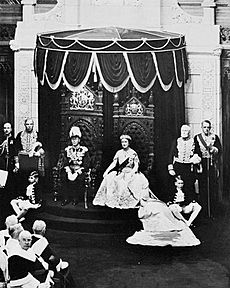Parliament of Canada facts for kids
Quick facts for kids Parliament of CanadaParlement du Canada |
|
|---|---|
| 45th Parliament | |
 |
|
| Type | |
| Type | |
| Houses | |
| History | |
| Founded | 1 July 1867 |
| Preceded by | Initially assumed some jurisdiction from:
Later added some jurisdiction from:
|
| Leadership | |
|
Charles III
Since 8 September 2022 |
|
|
Mary Simon
Since 26 July 2021 |
|
|
Raymonde Gagné, Non-affiliated
Since 12 May 2023 |
|
|
Francis Scarpaleggia, Liberal
Since 26 May 2025 |
|
| Structure | |
| Seats |
|
 |
|
|
Senate political groups
|
Independent Senators Group (45)
Canadian Senators Group (20) Progressive Senate Group (18) Conservative (14) Non-affiliated (6) Vacant (2) |
 |
|
|
House of Commons political groups
|
His Majesty's Government
His Majesty’s Loyal Opposition
Parties with official status
Parties without official status
|
| Elections | |
| Appointment by the governor general on advice of the prime minister | |
| First-past-the-post | |
|
House of Commons last election
|
28 April 2025 |
| Meeting place | |
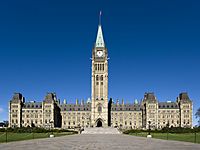 |
|
|
|
The Parliament of Canada (French: Parlement du Canada) is where important decisions are made for the entire country. It's like the main meeting place for Canada's government. It has three main parts:
- The King of Canada (represented by the Governor General)
- The Senate (often called the "upper house")
- The House of Commons (often called the "lower house")
Together, these three parts work to create and approve laws for Canada. This system, with two houses, is called bicameral.
The House of Commons has 343 members, called Members of Parliament (MPs). Each MP is chosen by voters in a specific area of Canada, known as an electoral district or riding. The Senate has 105 members, called senators. Senators are chosen by the Governor General, usually based on advice from the Prime Minister. Both MPs and Senators are sometimes called parliamentarians.
When a new idea for a law, called a "bill," is proposed, it usually starts in the House of Commons. Bills about money must always start there. The House of Commons is generally the most powerful part of Parliament. For a bill to become a law, it needs to be approved by both the House of Commons and the Senate. Finally, the King (through the Governor General) gives "Royal Assent," which means the bill officially becomes a law.
The Governor General also has important roles, like calling Parliament together, ending a session, or calling a new election. They also give a special speech, called the "Speech from the Throne," at the start of each new Parliament.
The most recent election for the 45th Canadian Parliament happened on April 28, 2025. After this election, a Liberal minority government was formed.
Contents
- How Canada's Parliament is Organized
- What Laws Can Parliament Make?
- Important People in Parliament
- How Long Does Parliament Last?
- How Parliament Makes Decisions
- How Laws Are Made: Legislative Functions
- How Parliament Works with the Government
- Special Rights of Parliament
- A Brief History of Canada's Parliament
- See also
How Canada's Parliament is Organized
Canada's Parliament is made up of three key parts: the King of Canada (represented by the Governor General), the Senate, and the House of Commons. Each part has its own leaders and ways of working. They all work together to create laws for the country. This way of organizing Parliament comes from the United Kingdom. Canada's Parliament works very similarly to the British Parliament, with a few small differences because Canada has its own unique history and traditions.
Only those who sit in the House of Commons are usually called Members of Parliament (MPs). The term is not usually used for Senators, even though the Senate is a part of Parliament. Senators hold higher positions in Canada's official order of importance. No one can be a member of both the Senate and the House of Commons at the same time.
The King's Role in Parliament
The King's role in making laws is called the King-in-Parliament. This role is set out in Canada's main rulebook, the Constitution Act, 1867. The King, or his representative the Governor General, doesn't usually take part in debates or voting on laws. Their main job is to give the King's approval, called Royal Assent, to a bill after both the Senate and House of Commons have passed it. This approval is needed for a bill to become a law.
Because the King and Governor General traditionally don't enter the House of Commons, any special ceremonies they are part of happen in the Senate chamber. Each house has a special staff called a mace. This mace shows the King's authority and the special rights given to Parliament. The mace for the House of Commons was replaced after a big fire in 1916. A temporary wooden mace is still used in the Senate on February 3rd each year to remember that fire.
All new Members of Parliament and Senators must promise their loyalty to the King. This is called the Oath of Allegiance. Even the main opposition party is called "His Majesty's Loyal Opposition." This shows that while they might disagree with the government's plans, they are still loyal to the King and Canada's system of government.
The Senate: Canada's Upper House
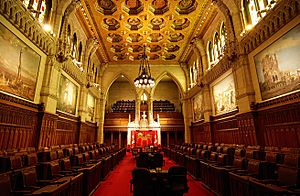
The upper house of Canada's Parliament is the Senate. It has 105 members, called Senators. Senators are chosen by the Governor General, usually based on advice from the Prime Minister. To become a Senator, a person must be at least 30 years old, be a Canadian citizen, and own property in the province they represent.
Senators used to serve for life. But since 1965, they must retire when they turn 75. Senators can also resign earlier or lose their position if they miss too many Parliament meetings.
The Senate is set up to give equal representation to different regions of Canada. There are 24 Senators for Ontario, 24 for Quebec, 24 for the Maritimes (10 for Nova Scotia, 10 for New Brunswick, and 4 for Prince Edward Island), and 24 for the Western provinces (6 each for Manitoba, British Columbia, Saskatchewan, and Alberta). Newfoundland and Labrador has 6 Senators, and each of Canada's three territories (the Northwest Territories, Yukon, and Nunavut) has 1 Senator. Sometimes, a few extra Senators can be appointed if the King agrees, but this is very rare. It has only happened once in Canada's history.
The House of Commons: Canada's Lower House
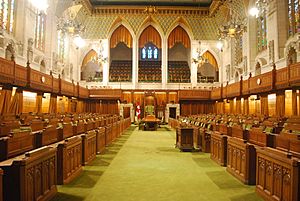
The House of Commons (French: Chambre des communes) is the elected part of Canada's Parliament. Each of its 343 members is chosen by voters in a federal electoral district, or riding. To run for a seat in the House of Commons, a person must be a Canadian citizen and at least 18 years old.
Each MP holds their job until Parliament is dissolved, after which they can run for re-election. The number of ridings and MPs changes every ten years after a national count of people (a census). However, some special rules in the Constitution make sure that provinces always have a certain number of MPs, which means the House of Commons has grown larger than its original size.
What Laws Can Parliament Make?
The Canadian Constitution divides the power to make laws between the federal Parliament and the provincial governments. Generally, provincial governments can only make laws about topics specifically given to them by the Constitution, like education, local governments, and things that are only important to their province.
The federal Parliament can make laws about anything not given exclusively to the provinces. This includes things like the postal service, the military, shipping, fishing, money, banking, copyrights, and matters related to First Nations. Sometimes, the powers can overlap. For example, both federal and provincial governments can make laws about taxes, borrowing money, and agriculture.
Parliament's powers are also limited by the Canadian Charter of Rights and Freedoms. This Charter protects the basic rights and freedoms of all Canadians. While there's a special rule called the "notwithstanding clause" that could allow Parliament to temporarily set aside some parts of the Charter, the federal government has never used it. If a law goes against the Constitution, courts can say it is not valid.
Important People in Parliament
Each of Parliament's two houses has a leader called a Speaker. The Speaker of the Senate is chosen by the Governor General, based on the Prime Minister's advice. The Speaker of the House of Commons is an MP who is elected by the other members of that house. The Speaker of the House of Commons usually has more power than the Speaker of the Senate.
The Usher of the Black Rod is a very important person in the Senate. They are the personal messenger for the King and Governor General to Parliament. The Usher is also in charge of security in the Senate and helps organize big events on Parliament Hill, like the Speech from the Throne.
Other important officials in Parliament include the Auditor General (who checks government spending), the Chief Electoral Officer (who runs elections), and the Official Languages Commissioner (who makes sure English and French are treated equally). These people are sometimes called Agents of Parliament and help Parliament work properly. There is also a Parliamentary Librarian who manages the Library of Parliament.
How Long Does Parliament Last?
The Constitution Act, 1867 says that only the Governor General can call Parliament to meet. The King also has the power to end a Parliament session (called proroguing) or end Parliament completely (called dissolving), which usually leads to a general federal election. After an election, the Governor General officially calls Parliament to assemble again. New MPs are sworn in, and then they elect their Speaker.
A new Parliament session begins with a special ceremony called the opening of Parliament. During this ceremony, the King, Governor General, or a royal representative gives a Speech from the Throne. This speech outlines the government's plans for the upcoming session. The Usher of the Black Rod invites MPs to these events by knocking on the closed doors of the House of Commons. This is a symbolic act showing the Commons' right to control who enters its chamber.
A parliamentary session lasts until it is prorogued. When this happens, both houses stop all their work until the Governor General calls for a new session. After several sessions, a Parliament ends, and a general election usually follows. General elections are typically held every four years on the third Monday in October. However, the Governor General can dissolve Parliament and call an election earlier, usually if the Prime Minister advises it, or if the government loses a motion of no confidence.
How Parliament Makes Decisions
Both the House of Commons and the Senate decide on ideas (called motions) by a voice vote. The person in charge, the Speaker, asks for "yea" (yes) or "nay" (no) shouts and then announces the winner. If members disagree with the Speaker's decision, they can ask for a recorded vote.
In a recorded vote, members stand up to be counted. The Speaker of the Senate can vote, but usually doesn't to stay neutral. If there's a tie in the Senate, the motion fails. In the House of Commons, the Speaker cannot vote unless there's a tie. The Speaker usually votes in a way that keeps the discussion open or avoids changing a bill, rather than making a final decision that could stop a bill or bring down the government.
For Parliament to do business, a certain number of members must be present. This is called a quorum. In the Senate, 15 Senators are needed. In the House of Commons, 20 members are needed, including the Speaker.
During all sessions, there is interpretation available for both official languages, English and French, so everyone can understand.
How Laws Are Made: Legislative Functions
New laws, called "bills" when they are still ideas, can be introduced by any member of either house. Most bills start in the House of Commons, and most of these are proposed by government ministers. These are called government bills. Bills proposed by individual MPs or Senators who are not ministers are called private members' bills or private senators' bills. Bills can also be public (for everyone) or private (for a specific person or group).
Each bill goes through several steps in both houses:
- First Reading: The bill is introduced.
- Second Reading: Members debate the main ideas of the bill.
- Committee Stage: The bill is sent to a committee. This is a group of members or Senators who specialize in a topic (like foreign affairs). They study the bill, listen to experts, debate it, and can suggest changes. Sometimes, the whole house acts as a committee.
- Report Stage: The whole house reviews any changes suggested by the committee. More changes can be made at this point.
- Third Reading: This is the final vote on the bill. In the House of Commons, no more changes can be made at this stage, but they can be in the Senate.
If a bill passes the third reading in one house, it is sent to the other house to go through the same steps. If both houses pass the bill in the exact same form, it moves to the next stage. If the houses disagree on changes, and they can't find a solution, the bill fails.
Once a bill is passed by both houses, it is presented for Royal Assent. In theory, the Governor General has three choices:
- Grant Royal Assent, making the bill a law.
- Refuse Royal Assent, which would stop the bill (this has never happened in Canada).
- Save the bill for the King's personal decision.
Even if the Governor General grants Royal Assent, the King could, within two years, cancel the law. However, this has also never happened.
Only the House of Commons can introduce bills about taxes or spending government money. Even though both houses need to agree for a bill to pass, the House of Commons is usually more powerful. This is because its members are directly elected by the people, so the Senate rarely goes against its decisions.
How Parliament Works with the Government
The federal government is made up of the King (represented by the Governor General) and a group of ministers. These ministers are usually chosen from Parliament, mostly from the House of Commons. They are responsible for leading the country.
Ministers are held accountable to the House of Commons, especially during "Question Period." This is a time when MPs from other parties can ask ministers questions about their work. The person who has the support of most members in the House of Commons (usually the leader of the party with the most seats) becomes the Prime Minister.
The House of Commons can try to remove the government by voting against a "motion of confidence" or by passing a "motion of no confidence." Important bills, like the budget, are always considered matters of confidence. If the government loses a confidence vote, the Prime Minister must either resign or ask the Governor General to call a new election.
Sometimes, people discuss how well the House of Commons can challenge the government. Because of how elections work, the party in power often has a strong majority. This can mean that there's less need for different parties to compromise. Also, party leaders have a lot of control over their members, which can make it harder for individual MPs to vote against their party's wishes.
However, if a government does not have a majority of seats (a minority government), it is more likely to lose a confidence vote. The last Prime Ministers to lose confidence votes were Stephen Harper in 2011, Paul Martin in 2005, and Joe Clark in 1979, all of whom led minority governments. In 2015, the Reform Act was passed to try and give individual MPs more power and independence.
Special Rights of Parliament
Parliament has special rights, known as parliamentary privilege. Each house protects its own rights. Parliament itself decides how far these rights go, but they cannot be greater than the rights held by the British Parliament's House of Commons in 1867.
One of the most important rights is freedom of speech during debates. Nothing said inside the Parliament chambers can be questioned by any court or outside group. This means MPs and Senators cannot be sued for things they say during parliamentary discussions. Also, MPs and Senators have some protection from being arrested for certain non-criminal matters while Parliament is meeting. They also don't have to serve on juries or appear in court as witnesses during this time. However, they can be disciplined by their colleagues if they break Parliament's rules.
On April 15, 2008, the Canadian Heraldic Authority confirmed that the Parliament of Canada has the right to use a special heraldic badge. This badge shows symbols of the three parts of Parliament: the shield from the Royal Arms of Canada with the maces of the House of Commons and Senate crossed behind it.
A Brief History of Canada's Parliament
After New France became part of the United Kingdom in 1763, Canada was governed by rules set by King George III. Later, the Quebec Act gave a governor and council the power to make rules, all chosen by the British King. In 1791, Quebec was split into Upper and Lower Canada, each with its own elected assembly, appointed council, and governor, much like Britain's Parliament.
During the War of 1812, American soldiers burned the buildings of the government in York (now Toronto). In 1841, the British government joined Upper and Lower Canada to form the Province of Canada. This new province had one legislature with an assembly, council, and a Governor General. The Governor General had a lot of power until 1848, when Canada gained "responsible government," meaning the government had to answer to the elected assembly.

The Parliament moved around a lot in the early days. It met in Kingston, then Montreal (where a fire destroyed its building in 1849), and also in Toronto and Quebec City. Finally, in 1856, Queen Victoria chose Ottawa as Canada's capital, and Parliament has been there ever since.
The modern-day Parliament of Canada began in 1867. In that year, the British Parliament passed the British North America Act, 1867. This law united the provinces of New Brunswick, Nova Scotia, and Canada (which was split into Quebec and Ontario) into a new country called the Dominion of Canada. The new federal Parliament was very similar to the British Parliament. This choice was influenced by the recent American Civil War, which made many Canadians want a stronger central government. The British North America Act gave the Canadian Parliament power over all matters not specifically given to the provinces.
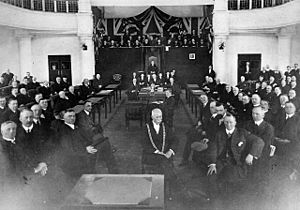
In 1931, a law called the Statute of Westminster gave Canada more power to make its own laws, independent from Britain. However, Canada still needed Britain's help to change its own Constitution.
While her father, King George VI, was the first Canadian monarch to give royal assent in the legislature in 1939, Queen Elizabeth II was the first King or Queen to deliver the speech from the throne in 1957. This was also the first time television cameras were allowed into Parliament, as the Canadian Broadcasting Corporation broadcast the speech across the country.
The last time Canada asked the British Parliament to change its Constitution was in 1982. This led to the Canada Act 1982 which included the Constitution Act, 1982. These laws meant that Britain no longer had any power to make laws for Canada. From then on, Canada could change its own Constitution by itself, with agreement from the federal Parliament and most of the provincial governments.
See also
 In Spanish: Parlamento de Canadá para niños
In Spanish: Parlamento de Canadá para niños
- Canadian Parliament Buildings
- Hansard
- Joint address (Canada)
- List of Canadian federal parliaments
- List of legislatures by country
- Politics of Canada
- Procedural officers and senior officials of the Parliament of Canada
- Records of members of the Parliament of Canada


